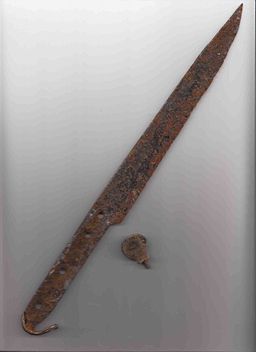Typically the size (and shape) of a modern chef's knife, they were sometimes the size of a machete. The Tres Espadas logo has a Gladius, a Cutlas and a Kukri, all of which have machete and large knife variations:
At Tres Espadas we have a very high emphasis on learning to fight with the large knife (Bowie knife or chef's knife,) and in fact it is the first skill set we suggest beginners learn:
Just as the bauernwehr above was ubiquitous in the dark ages, chef's knives are ubiquitous in domestic kitchens throughout the USA (and many other parts of the world.) The bauernwehr was considered the critical home defense tool of it's day, and the founders of Tres Espadas see the chef's knife to be a critical home defense weapon in today's world. It is one thing to praise the 2nd Amendment's supposed guarantee of home defense through firearms, it is another thing to encourage universal home defense through the study of chef's knife self-defense techniques.
Most indoors confrontations are close range. Knives can have significant advantages over guns at close range:
Most homes don't even have a gun. Of the homes with guns, few gun owners actually go out and practice using their weapon at the firing range, meaning they are almost completely incompetent with the weapon. Of those who actually bother to train with their guns, fewer still go hunting, do Airsoft, play paintball, or do any other training against live targets who don't want to be shot. (The founders of Tres Espadas do know gun owners who take their semi-auto rifles to the range frequently and have been on highly competitive paintball teams, but we think this level of training represents far less than 1% of the gun owners in the USA.) People seriously interested in home defense should give chef's knife self defense techniques serious study:
If you are a skilled gunslinger, the one other thing to consider about the chef's knife besides its ubiquity is its silence. Almost anything you do with a gun makes noise, where as a chef's knife can be handled very quietly. A well trained and prepared knife fighter at close range can take a home invader without altering other possible armed accomplices he may have.


